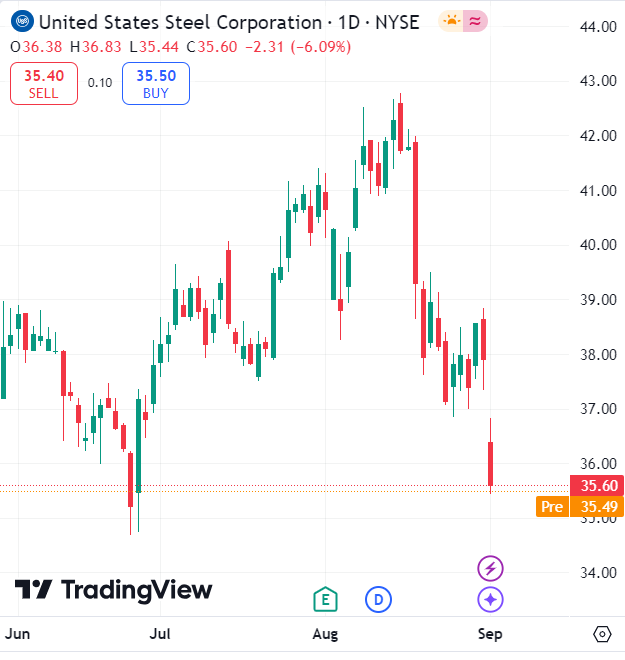US Steel Stock: Seemingly Strong Value Gets Clouded by Political Posturing
2024.09.04 13:07
United States Steel Corporation (NYSE:) stock slid -6.09% Tuesday afternoon as U.S. Vice President and presidential candidate Kamala Harris strongly opposed Japanese steel producer Nippon Steel‘s proposed takeover of U.S. Steel.
Consequently, it’s now clear that both Harris and former president and current presidential candidate Donald Trump strongly oppose the Nippon-U.S. Steel takeover bid.
NYSE:X price 09/03/24 | Source: TradingView
Traditional valuation metrics may suggest that buying X stock’s perfectly safe since it appears reasonably priced.
However, with the U.S. presidential election still two months away, it’s wise to let political events play out as they will and to wait on the sidelines rather than jump into a hasty investment.
Nippon Steel detailed its policy on Wednesday, assuring that will remain a US company that Nippon Steel North America, Inc.. will own.
Acquisition Would Benefit U.S. Steel
At this point, you might wonder why Nippon Steel’s potential takeover of U.S. Steel would matter so much. For one thing, Nippon is a much bigger company than U.S. Steel and could bring deep capital and human resources to the table.
Furthermore, while U.S. Steel isn’t collapsing by any means, it also could benefit from a financial bailout. The company’s second-quarter 2024 report reveals a number of issues that might not be resolved anytime soon unless there’s a miraculous rally in the steel price.
U.S. Steel CEO David Burritt bragged that the company’s “adjusted EBITDA of $443 million improved sequentially.” Sure, but U.S. Steel’s adjusted EBITDA also fell sharply when compared to $804 million in the year-earlier quarter.
Furthermore, U.S. Steel generated Q2-2024 net sales of $4.118 billion, down from $5.008 billion in the year-earlier quarter. In addition, the company’s adjusted net earnings of $0.84 per share were less than half of the $1.92 per share that U.S. Steel earned in 2023’s second quarter.
Using typical executive-speak, Burritt blamed “pricing headwinds” and a “dynamic market.” I would interpret these phrases as an unfavorable steel supply-to-demand balance exacerbated by high production costs for U.S. Steel.
Predicting whether these “dynamics” will improve in the coming months is impossible. However, Burritt inserted a hopeful note when he declared, “We continue to make progress on the U.S. regulatory processes ahead of the anticipated closing of our transaction with Nippon Steel Corporation later this year.”
Was it too soon to confidently “anticipate” Nippon’s takeover of U.S. Steel?
Trump and Harris Oppose Nippon-U.S. Steel Buyout
It’s probably hasty to “anticipate” a Nippon-U.S. Steel buyout in the near term. Last month, Trump said, “I will stop Japan from buying United States Steel… They shouldn’t be allowed to buy it.”
U.S. Steel replied in a statement that the company is “committed to the transaction with Nippon Steel, which is the best deal for our employees, shareholders, communities, and customers.” Still, it’s awfully hard to fight the White House and win.
Trump might not be in the White House in January, but Harris, his rival presidential candidate, recently opposed the Nippon-U.S. Steel acquisition. “U.S. Steel is a historic American company, and it is vital for our nation to maintain strong American steel companies,” Harris asserted.
Harris declared this just a few days after Nippon Steel sweetened the potential deal by pledging to invest an additional $1.3 billion U.S. Steel if the takeover deal goes through. In December, U.S. Steel accepted Nippon’s takeover bid in a deal valued at $14.9 billion.
Considering U.S. Steel’s Valuation
Another consideration is U.S. Steel’s valuation, which looks appealing if you focus on some old-school metrics. For example, U.S. Steel’s GAAP-measured trailing 12-month price-to-earnings (P/E) ratio of 16.65 appears to be more favorable than the sector median P/E ratio of 22.69.
Moreover, on a trailing 12-month basis, U.S. Steel has an ultra-low price-to-sales (P/S) ratio of 0.5 (versus the sector median P/S ratio of 1.4) and a price-to-book (P/B) ratio of 0.75 (versus the sector median P/B ratio of 1.76).
These are important metrics and shouldn’t just be ignored. However, they don’t tell the full story about U.S. Steel’s situation. It’s risky to buy X stock or any other stock solely because the company’s P/E ratio and similar metrics are down.
Don’t Be Too Confident
U.S. Steel isn’t just giving up on the potential Nippon Steel buyout bid. “We’re confident that Nippon Steel’s acquisition of U.S. Steel will revitalize the American steel rust belt, benefit American workers, local communities, and national security in a way no other alternative can,” U.S. Steel insists.
Yet, just because U.S. Steel is confident doesn’t necessarily mean you should also be confident. Both Trump and Harris seek to court voters who want to keep U.S. Steel American-owned. So, it’s unlikely that they will soften their stances on this issue in the coming months.
The winner of the presidential race might eventually soften his or her stance, but that’s not guaranteed. Consequently, even if you like U.S. Steel’s valuation numbers, it’s wise to step aside and let politics play out, as X stock could remain volatile throughout 2024 and into early 2025.
Original Post








